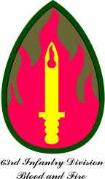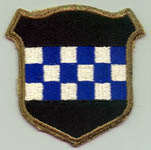
Birth and Death of a
World War II Army
Camp- Camp Van Dorn,
Mississippi- Page 2
World War II Army
Camp- Camp Van Dorn,
Mississippi- Page 2

99th Infantry Division
| Let us back up to 16 May 1941: A Lieutenant Homer Harris arrived in Centreville from New Orleans. He had been in New Orleans since 1 April awaiting orders to come to Centerville to supervise construction of the local camp. Lt Harris departed on a Wednesday for New Orleans to await further orders. Then lo and behold the War Department announced on Tuesday the "The Centreville project was unsuitable for development as a Division training camp". This announcement must have been traumatic to the folks that had worked so hard to secure this camp; however, the article stated "leaders continue to express confidence in the ultimate location of a camp here". Apparently everything was on "hold" from about June until 7 December 1941. Very little information was published, that I could find. At this time I was soldiering in the Dixie Division (31st Infantry Division) at Camp Blanding, Florida. The Carolina and Louisiana maneuvers had been completed and then "The Day of Infamy"! BUILDING AND NAMING CAMP VAN DORN I found an article from the McComb paper dated 22 December 1941 stating that preliminary detail work of abstracting, perfecting titles, making a complete set of plans and blue prints for streets, lighting systems, grading and drainage, sewage systems, and the thousand and one other matters to be handled began in Centreville today for the projected army camp! Policy seems to be that within one month these detailed estimates of the camp's cost, with complete plans for its building will be submitted to the War Department for approval or rejection and of course, if approved, the Army Engineers and construction companies receiving contacts will begin work. At this time we were hearing the figure of $30,000,000 being mentioned and 72 sections of land embracing about 46,000 acre, employment of 10,000! February of 1941 sees much activity in the area. 25 February 1942: Contact let on Wednesday to Solomon & Kies of Troy, New York engineering firm that will lay out and supervise construction of the camp. R. W. Naef, architect/engineer, from Jackson, Mississippi, will assist. Mayor Robinson recommended that farmers go ahead and plant crops--this will be taken into consideration in estimating land values. The old work horse, the Mayor of Centreville, Lee B. Robinson, did not live to see his project completed as he died the latter part of February 1942. April and May 1942 saw railroad spurs being built, warehouses constructed and a contract let for 26.3 miles of camp roads. Construction of barracks, headquarters buildings, latrines and so forth to be built after camp roads are in place. At the close of business, 4 April 1942, the Farmers Exchange Bank of Centreville listed assets of $388,187.73. I could not locate the record of assets for 31 December 1944- by this time the 63rd Division had departed for Europe, leaving only non-divisional units on post. Bank records indicate as of 30 May 1964, just before a merger, assets were $2,100,000. Yes, there was an impact on the economy. In 1942, plate lunches at one of the local cafes went for 35 cents, regular dinner for 50 cents. This whole operation really boggles my mind; the logistics involved, contracts let in February 1942, streets, utilities and actual building of barracks in June 1942 and first troops moving in for training in November 1942. New troops, mostly Yankees, were greeted with the sound of hammers and saws, cold and mud and ah!!, later on the chiggers. This camp was not one of frills. It was ofter referred to as a "Theatre of Operations Camp". Come here, learn the business of killing and how to save your own life. Tar paper barracks was the norm, heated by coal heaters. An article in the Woodville Republican dated 4 Jul 1942 indicated that the name selected for this camp would be "Camp Van Dorn". Major General Earl Van Dorn led a very colorful life having roots in Port Gibson, Mississippi. Born in 1820, attending West Point at age 16 and taking part in Scott's Campaign in Mexico with the 7th Infantry. General Van Dorn resigned his commission in the United States Army in 1861 offering his services to the Confederacy. As a matter of record his most renowned battle was routing Union forces at Holly Springs, Mississippi in December 1862. Quarterly inventory of War Depatment assets ending 31 December 1945 concerning owned, sponsored, and leased facilities at Camp Van Dorn show that barracks/buildings could accommodate 39,114 enlisted men and 2,173 officers. Normal bed capacity for the Station Hospital was 750. It is highly unlikely that Camp Van Dorn ever reached capacity. Information gleaned from this same source shows that the War Department owned 41,843 acres, with one (1) acre being leased- at total of 41,844 acres. Storage capacity: Covered square feet were 395,000 and open square feet were 5,894,959. A small detachment of POW's were imprisoned at Camp Van Dorn Cost to the Government from inception- source indicated 1 July 1940- through 31 December 1945: Land: $768,079 Construction $20,971,830 The War Department leased what was known as the Van Dorn/Natchez Bivouac Area Sub-Post. This was 25 acres with enough tents to house 450 enlisted personnel and 8 officers. Covered storage of 648 square feet and cost to the government since 1 June 1940 to $12,000. MOVEMENT OF TROOPS: DIVISIONAL AND NON-DIVISIONAL It is now the 15th day of November 1942. Prior to this date a cadre from the 7th Infantry Division had been in place a short time awaiting activation and fillers for the 99th Infantry Division. This Division was originally constituted 23 July 1918, organized in October 1918 at Camp Wheeler, Georgia and demobilized in November 1918 at the same station. The 99th was allotted to the organized reserves in 1921, reorganized and ordered to active military service 15 November 1942 at Camp Van Dorn, Mississippi. Fillers actually started to arrive on 6 December 1942. Of course troops arrived from many Reception Centers, most from the North and Northeast. The 99th, known as the Checkboard Division, shoulder patch is a five sided shield of black on which is superimposed a horizontal band of white and blue squares. The black background of shield represents the iron district of Pennsylvania. Originally planned as a Pennsylvania unit. the band of white and blue squares were taken from the coat of arms of William Pitt, for who the city of Pittsburgh was named. (Webmaster's Note: The 99th Infantry Division Patch appears at the upper righthand corner of this page) The 99th, a triangular division, was made up of 3 infantry regiments, 4 field artillery battalions, engineer battaltion, medical battalion, recon troop, signal, ordnance and quartermaster companies plus special troops --band and division MP's. Major General Walter W. Laurer, author of "Battle Babies" and Division Commander writes. "When raw recruits arrived early in December 1942, the picture they viewed was far from rosy. Camp Van Dorn hastily built as the army mushroomed in every direction was a tar paper shanty town sprawled across the red mud of Southern Mississippi. Men of the Division not only faced basic training but one of the most miserable winters in years. Both service clubs burned down by Christmas, only one small theatre for 20,000 men. Any town of more than 2,000 population was 50 miles distant, besides were were no busses. The men had to help dig ditches to drain the camp, build walks, paint signs and ready the camp for training which began 4 January 1943" The 99th endured, completed their basic and advance training at Van Dorn and moved on to the Louisiana Maneuvers on 16 September 1943. Completing these maneuvers in November 1943, the Division moved to its new home of Camp Maxey, Texas, just a year after its activation at Camp Van Dorn. Combat record will be reviewd later in this research paper. The editorial "Farewell Camp Van Dorn" which appeared in the Division newspaper- The Checkerboard- states in part: "It is with a mixed feeling of regret and relief that this departure is being made. What we have lacked in physical comfort was more than comnpensated for through warm friendship of civilians in our neighboring communities who have extended to us the hospitality of their homes and facilities". The 99th had hardly cleared the camp when the 63rd Infantry (Blood and Fire) Division was moving in. This outfit was activated on 15 June 1943 at Camp Blanding, Florida. Their cadre was from the 98th Infantry Division, Camp Breckinridge, Kentucky. The cadre was there but they had no troops to train in Camp Blanding. There were rumors of a pending move, but where, no one ever guessed it would be Camp Van Dorn because no one had ever heard of this camp. The move was completed in August/September 1943. Immediately on settling down at Van Dorn the fillers began to arrive, again most from the North and East-- Pennsylvania, New York, New Jersey, Ohio. (Webmasters note: Also from Virginia and Maryland- I was a filler from Virginia) Of course, the 63rd moved into an established camp--beautiful place, cause I had occasion to visit out there while on leave from the Air Force, but I understand there was some disgruntled soldiers! |
UR here: VanDornHis page1> VanDornHis page 2>
17 Oct 13
| Contents |